Economics Assignment: Evaluating Trade Theories in the Modern World
VerifiedAdded on 2020/04/21
|12
|2879
|97
Essay
AI Summary
This economics assignment analyzes various international trade theories, starting with mercantilism and progressing through absolute advantage, comparative advantage, and the Heckscher-Ohlin theory. It examines the evolution of these theories and their effectiveness in explaining contemporary trade patterns. The essay highlights the Leontief Paradox, which challenges the Heckscher-Ohlin theory, and explores explanations for this anomaly. Furthermore, it delves into new trade theories, such as the international product life cycle theory, to provide a more comprehensive understanding of modern international trade dynamics. The assignment provides a detailed overview of the evolution of trade theories and their relevance in the current global economic landscape, offering insights into the complexities of international trade and its theoretical underpinnings.
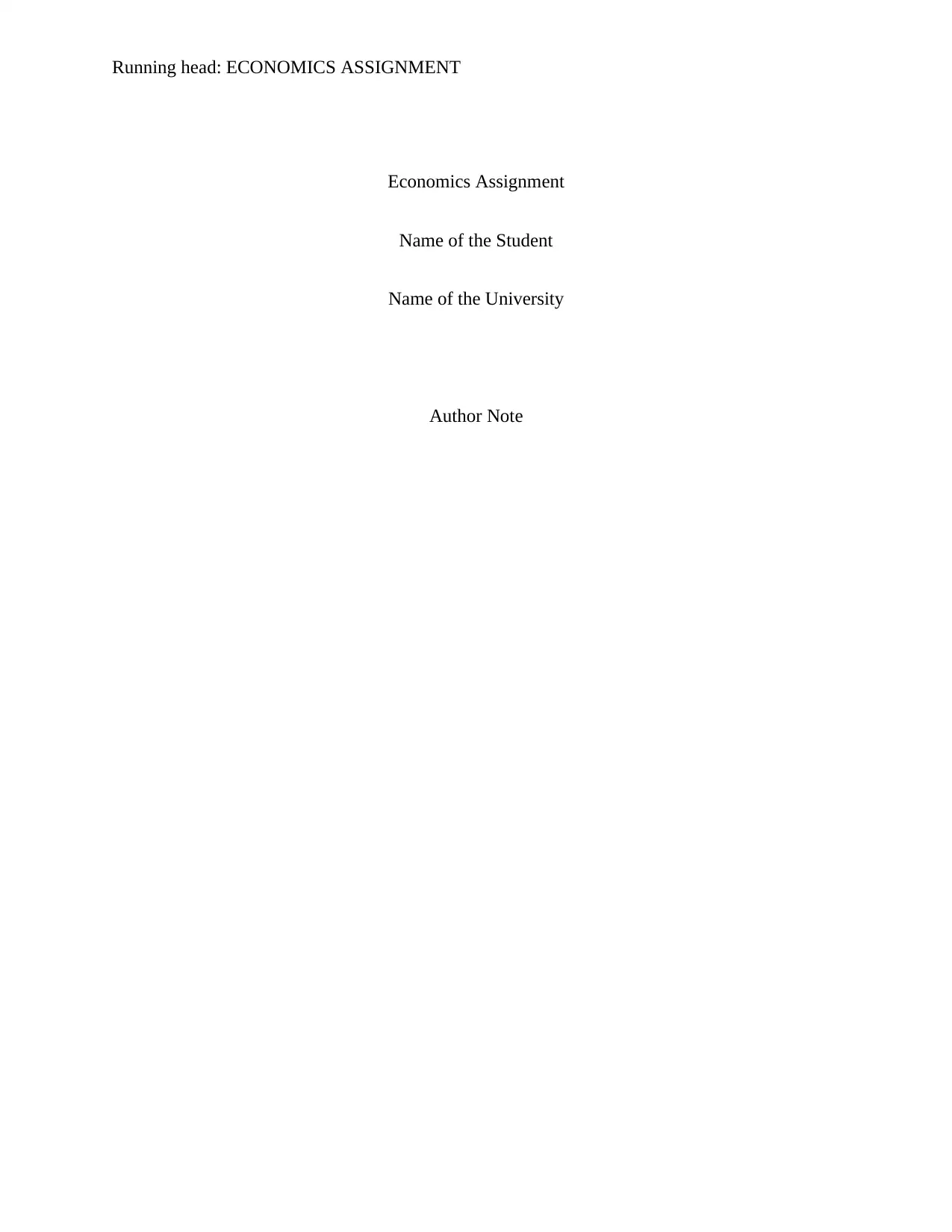
Running head: ECONOMICS ASSIGNMENT
Economics Assignment
Name of the Student
Name of the University
Author Note
Economics Assignment
Name of the Student
Name of the University
Author Note
Paraphrase This Document
Need a fresh take? Get an instant paraphrase of this document with our AI Paraphraser
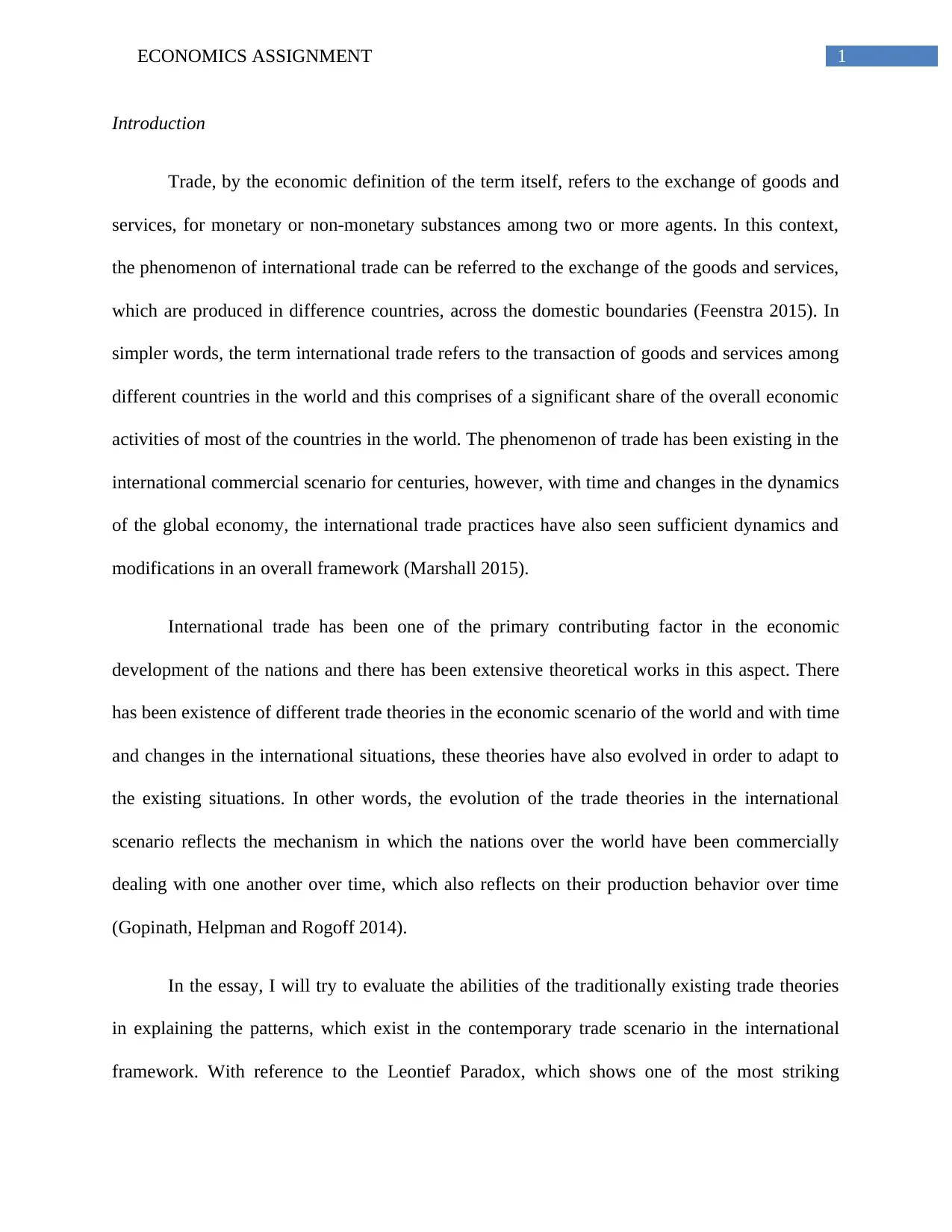
1ECONOMICS ASSIGNMENT
Introduction
Trade, by the economic definition of the term itself, refers to the exchange of goods and
services, for monetary or non-monetary substances among two or more agents. In this context,
the phenomenon of international trade can be referred to the exchange of the goods and services,
which are produced in difference countries, across the domestic boundaries (Feenstra 2015). In
simpler words, the term international trade refers to the transaction of goods and services among
different countries in the world and this comprises of a significant share of the overall economic
activities of most of the countries in the world. The phenomenon of trade has been existing in the
international commercial scenario for centuries, however, with time and changes in the dynamics
of the global economy, the international trade practices have also seen sufficient dynamics and
modifications in an overall framework (Marshall 2015).
International trade has been one of the primary contributing factor in the economic
development of the nations and there has been extensive theoretical works in this aspect. There
has been existence of different trade theories in the economic scenario of the world and with time
and changes in the international situations, these theories have also evolved in order to adapt to
the existing situations. In other words, the evolution of the trade theories in the international
scenario reflects the mechanism in which the nations over the world have been commercially
dealing with one another over time, which also reflects on their production behavior over time
(Gopinath, Helpman and Rogoff 2014).
In the essay, I will try to evaluate the abilities of the traditionally existing trade theories
in explaining the patterns, which exist in the contemporary trade scenario in the international
framework. With reference to the Leontief Paradox, which shows one of the most striking
Introduction
Trade, by the economic definition of the term itself, refers to the exchange of goods and
services, for monetary or non-monetary substances among two or more agents. In this context,
the phenomenon of international trade can be referred to the exchange of the goods and services,
which are produced in difference countries, across the domestic boundaries (Feenstra 2015). In
simpler words, the term international trade refers to the transaction of goods and services among
different countries in the world and this comprises of a significant share of the overall economic
activities of most of the countries in the world. The phenomenon of trade has been existing in the
international commercial scenario for centuries, however, with time and changes in the dynamics
of the global economy, the international trade practices have also seen sufficient dynamics and
modifications in an overall framework (Marshall 2015).
International trade has been one of the primary contributing factor in the economic
development of the nations and there has been extensive theoretical works in this aspect. There
has been existence of different trade theories in the economic scenario of the world and with time
and changes in the international situations, these theories have also evolved in order to adapt to
the existing situations. In other words, the evolution of the trade theories in the international
scenario reflects the mechanism in which the nations over the world have been commercially
dealing with one another over time, which also reflects on their production behavior over time
(Gopinath, Helpman and Rogoff 2014).
In the essay, I will try to evaluate the abilities of the traditionally existing trade theories
in explaining the patterns, which exist in the contemporary trade scenario in the international
framework. With reference to the Leontief Paradox, which shows one of the most striking
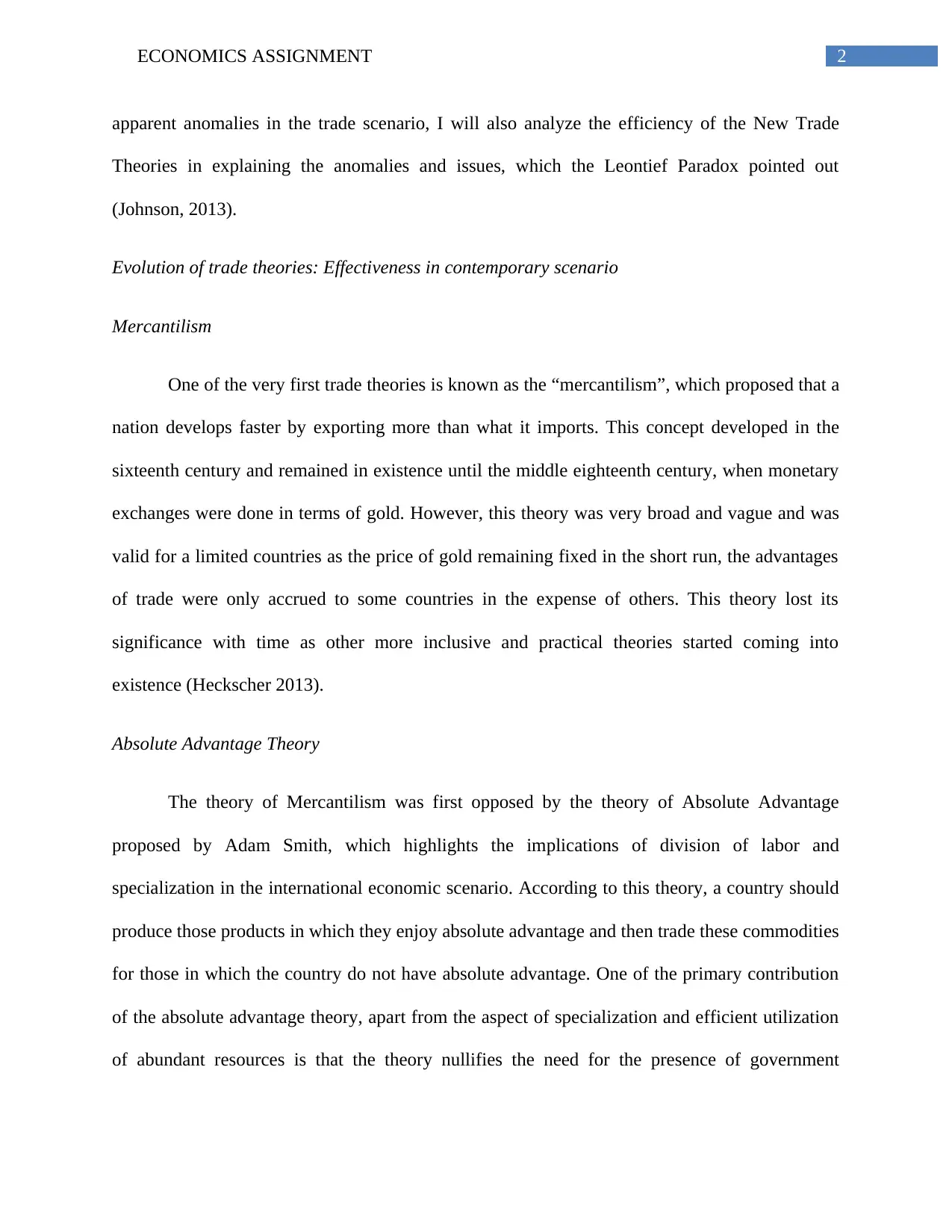
2ECONOMICS ASSIGNMENT
apparent anomalies in the trade scenario, I will also analyze the efficiency of the New Trade
Theories in explaining the anomalies and issues, which the Leontief Paradox pointed out
(Johnson, 2013).
Evolution of trade theories: Effectiveness in contemporary scenario
Mercantilism
One of the very first trade theories is known as the “mercantilism”, which proposed that a
nation develops faster by exporting more than what it imports. This concept developed in the
sixteenth century and remained in existence until the middle eighteenth century, when monetary
exchanges were done in terms of gold. However, this theory was very broad and vague and was
valid for a limited countries as the price of gold remaining fixed in the short run, the advantages
of trade were only accrued to some countries in the expense of others. This theory lost its
significance with time as other more inclusive and practical theories started coming into
existence (Heckscher 2013).
Absolute Advantage Theory
The theory of Mercantilism was first opposed by the theory of Absolute Advantage
proposed by Adam Smith, which highlights the implications of division of labor and
specialization in the international economic scenario. According to this theory, a country should
produce those products in which they enjoy absolute advantage and then trade these commodities
for those in which the country do not have absolute advantage. One of the primary contribution
of the absolute advantage theory, apart from the aspect of specialization and efficient utilization
of abundant resources is that the theory nullifies the need for the presence of government
apparent anomalies in the trade scenario, I will also analyze the efficiency of the New Trade
Theories in explaining the anomalies and issues, which the Leontief Paradox pointed out
(Johnson, 2013).
Evolution of trade theories: Effectiveness in contemporary scenario
Mercantilism
One of the very first trade theories is known as the “mercantilism”, which proposed that a
nation develops faster by exporting more than what it imports. This concept developed in the
sixteenth century and remained in existence until the middle eighteenth century, when monetary
exchanges were done in terms of gold. However, this theory was very broad and vague and was
valid for a limited countries as the price of gold remaining fixed in the short run, the advantages
of trade were only accrued to some countries in the expense of others. This theory lost its
significance with time as other more inclusive and practical theories started coming into
existence (Heckscher 2013).
Absolute Advantage Theory
The theory of Mercantilism was first opposed by the theory of Absolute Advantage
proposed by Adam Smith, which highlights the implications of division of labor and
specialization in the international economic scenario. According to this theory, a country should
produce those products in which they enjoy absolute advantage and then trade these commodities
for those in which the country do not have absolute advantage. One of the primary contribution
of the absolute advantage theory, apart from the aspect of specialization and efficient utilization
of abundant resources is that the theory nullifies the need for the presence of government
⊘ This is a preview!⊘
Do you want full access?
Subscribe today to unlock all pages.

Trusted by 1+ million students worldwide
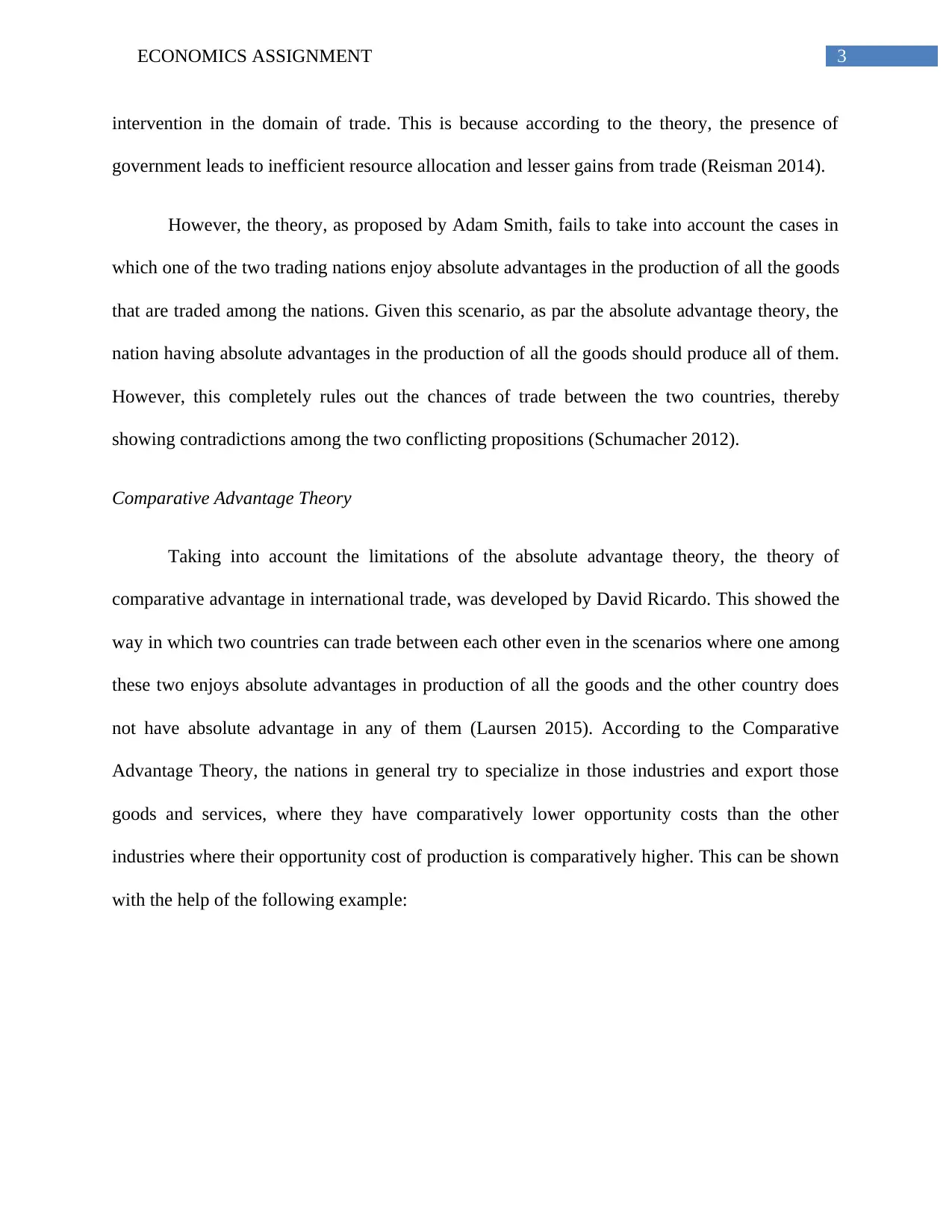
3ECONOMICS ASSIGNMENT
intervention in the domain of trade. This is because according to the theory, the presence of
government leads to inefficient resource allocation and lesser gains from trade (Reisman 2014).
However, the theory, as proposed by Adam Smith, fails to take into account the cases in
which one of the two trading nations enjoy absolute advantages in the production of all the goods
that are traded among the nations. Given this scenario, as par the absolute advantage theory, the
nation having absolute advantages in the production of all the goods should produce all of them.
However, this completely rules out the chances of trade between the two countries, thereby
showing contradictions among the two conflicting propositions (Schumacher 2012).
Comparative Advantage Theory
Taking into account the limitations of the absolute advantage theory, the theory of
comparative advantage in international trade, was developed by David Ricardo. This showed the
way in which two countries can trade between each other even in the scenarios where one among
these two enjoys absolute advantages in production of all the goods and the other country does
not have absolute advantage in any of them (Laursen 2015). According to the Comparative
Advantage Theory, the nations in general try to specialize in those industries and export those
goods and services, where they have comparatively lower opportunity costs than the other
industries where their opportunity cost of production is comparatively higher. This can be shown
with the help of the following example:
intervention in the domain of trade. This is because according to the theory, the presence of
government leads to inefficient resource allocation and lesser gains from trade (Reisman 2014).
However, the theory, as proposed by Adam Smith, fails to take into account the cases in
which one of the two trading nations enjoy absolute advantages in the production of all the goods
that are traded among the nations. Given this scenario, as par the absolute advantage theory, the
nation having absolute advantages in the production of all the goods should produce all of them.
However, this completely rules out the chances of trade between the two countries, thereby
showing contradictions among the two conflicting propositions (Schumacher 2012).
Comparative Advantage Theory
Taking into account the limitations of the absolute advantage theory, the theory of
comparative advantage in international trade, was developed by David Ricardo. This showed the
way in which two countries can trade between each other even in the scenarios where one among
these two enjoys absolute advantages in production of all the goods and the other country does
not have absolute advantage in any of them (Laursen 2015). According to the Comparative
Advantage Theory, the nations in general try to specialize in those industries and export those
goods and services, where they have comparatively lower opportunity costs than the other
industries where their opportunity cost of production is comparatively higher. This can be shown
with the help of the following example:
Paraphrase This Document
Need a fresh take? Get an instant paraphrase of this document with our AI Paraphraser
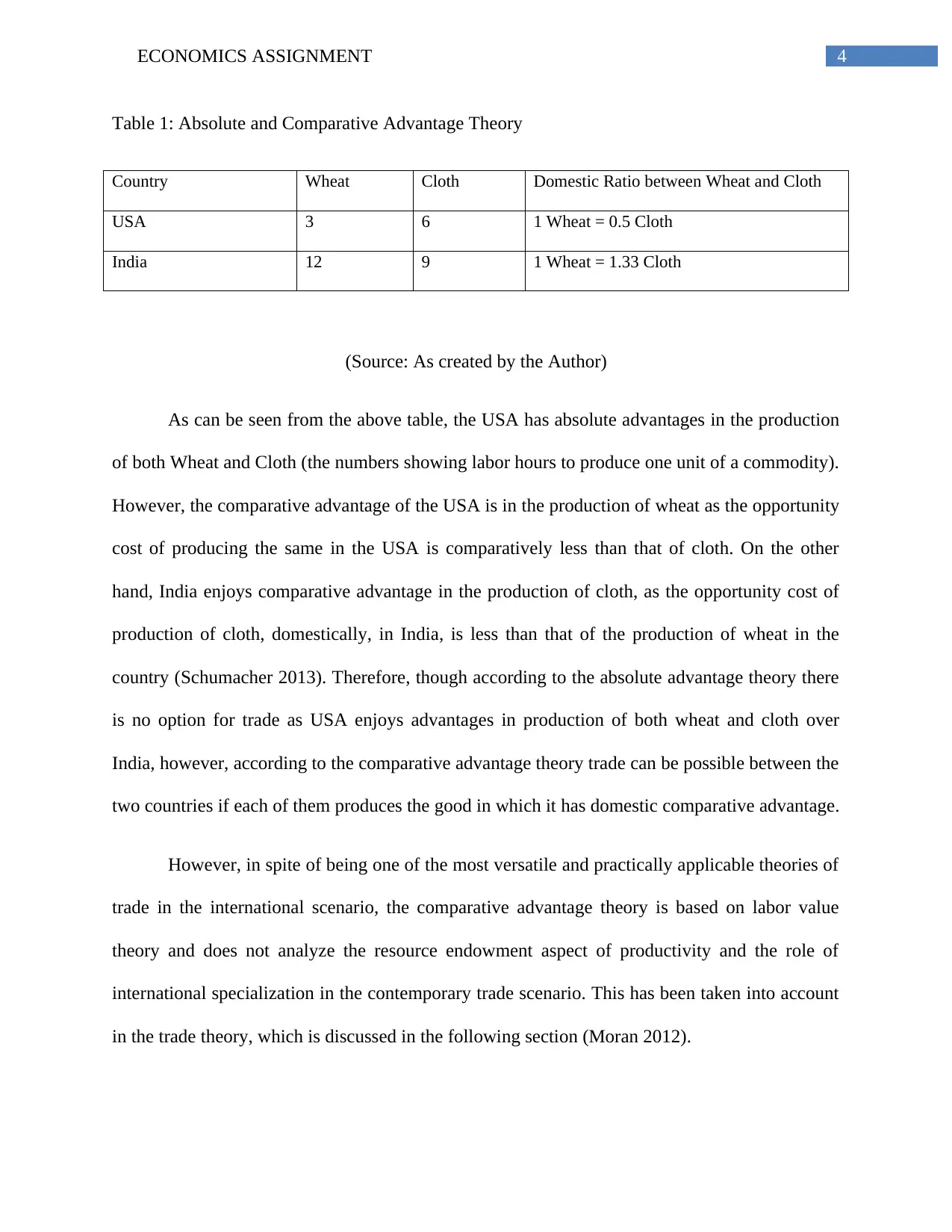
4ECONOMICS ASSIGNMENT
Table 1: Absolute and Comparative Advantage Theory
Country Wheat Cloth Domestic Ratio between Wheat and Cloth
USA 3 6 1 Wheat = 0.5 Cloth
India 12 9 1 Wheat = 1.33 Cloth
(Source: As created by the Author)
As can be seen from the above table, the USA has absolute advantages in the production
of both Wheat and Cloth (the numbers showing labor hours to produce one unit of a commodity).
However, the comparative advantage of the USA is in the production of wheat as the opportunity
cost of producing the same in the USA is comparatively less than that of cloth. On the other
hand, India enjoys comparative advantage in the production of cloth, as the opportunity cost of
production of cloth, domestically, in India, is less than that of the production of wheat in the
country (Schumacher 2013). Therefore, though according to the absolute advantage theory there
is no option for trade as USA enjoys advantages in production of both wheat and cloth over
India, however, according to the comparative advantage theory trade can be possible between the
two countries if each of them produces the good in which it has domestic comparative advantage.
However, in spite of being one of the most versatile and practically applicable theories of
trade in the international scenario, the comparative advantage theory is based on labor value
theory and does not analyze the resource endowment aspect of productivity and the role of
international specialization in the contemporary trade scenario. This has been taken into account
in the trade theory, which is discussed in the following section (Moran 2012).
Table 1: Absolute and Comparative Advantage Theory
Country Wheat Cloth Domestic Ratio between Wheat and Cloth
USA 3 6 1 Wheat = 0.5 Cloth
India 12 9 1 Wheat = 1.33 Cloth
(Source: As created by the Author)
As can be seen from the above table, the USA has absolute advantages in the production
of both Wheat and Cloth (the numbers showing labor hours to produce one unit of a commodity).
However, the comparative advantage of the USA is in the production of wheat as the opportunity
cost of producing the same in the USA is comparatively less than that of cloth. On the other
hand, India enjoys comparative advantage in the production of cloth, as the opportunity cost of
production of cloth, domestically, in India, is less than that of the production of wheat in the
country (Schumacher 2013). Therefore, though according to the absolute advantage theory there
is no option for trade as USA enjoys advantages in production of both wheat and cloth over
India, however, according to the comparative advantage theory trade can be possible between the
two countries if each of them produces the good in which it has domestic comparative advantage.
However, in spite of being one of the most versatile and practically applicable theories of
trade in the international scenario, the comparative advantage theory is based on labor value
theory and does not analyze the resource endowment aspect of productivity and the role of
international specialization in the contemporary trade scenario. This has been taken into account
in the trade theory, which is discussed in the following section (Moran 2012).
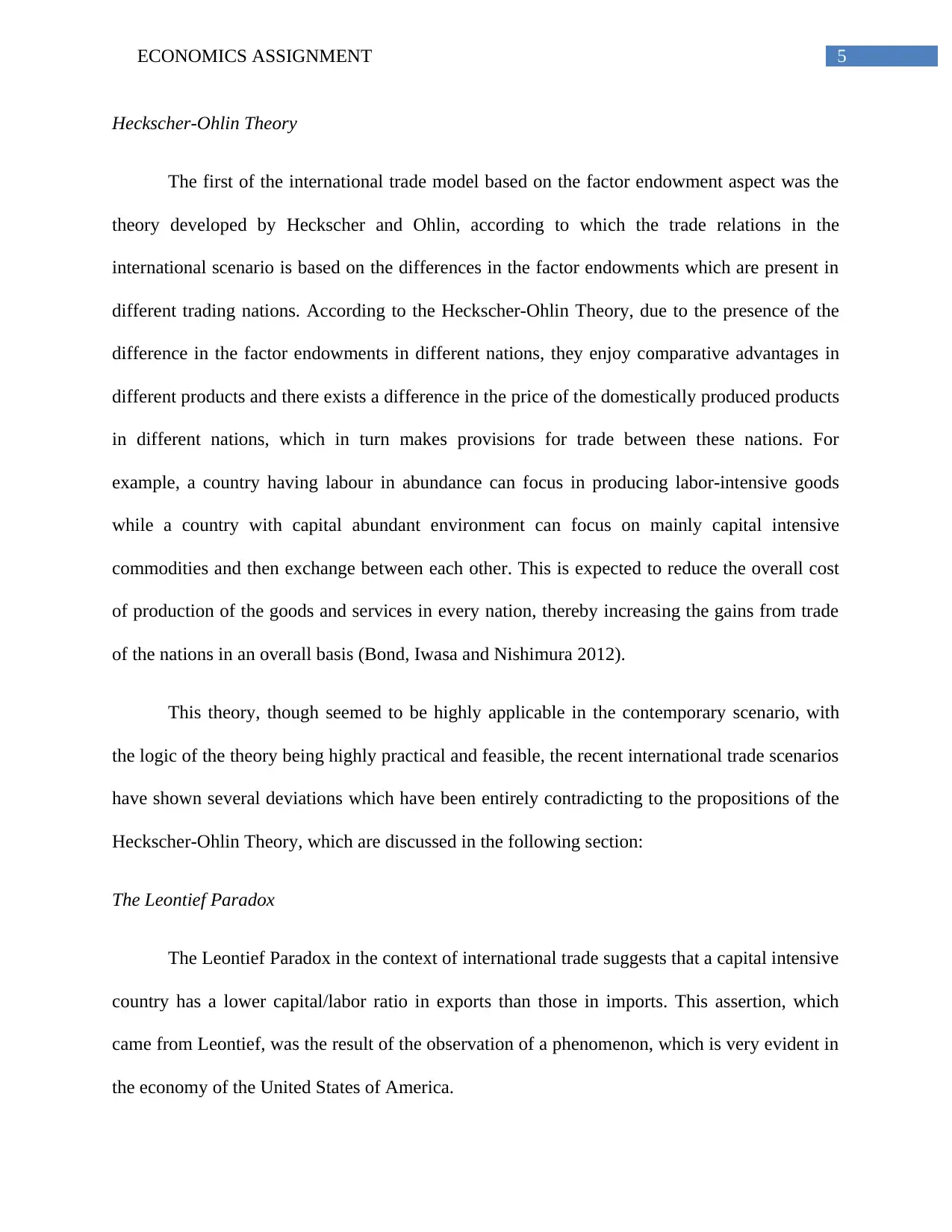
5ECONOMICS ASSIGNMENT
Heckscher-Ohlin Theory
The first of the international trade model based on the factor endowment aspect was the
theory developed by Heckscher and Ohlin, according to which the trade relations in the
international scenario is based on the differences in the factor endowments which are present in
different trading nations. According to the Heckscher-Ohlin Theory, due to the presence of the
difference in the factor endowments in different nations, they enjoy comparative advantages in
different products and there exists a difference in the price of the domestically produced products
in different nations, which in turn makes provisions for trade between these nations. For
example, a country having labour in abundance can focus in producing labor-intensive goods
while a country with capital abundant environment can focus on mainly capital intensive
commodities and then exchange between each other. This is expected to reduce the overall cost
of production of the goods and services in every nation, thereby increasing the gains from trade
of the nations in an overall basis (Bond, Iwasa and Nishimura 2012).
This theory, though seemed to be highly applicable in the contemporary scenario, with
the logic of the theory being highly practical and feasible, the recent international trade scenarios
have shown several deviations which have been entirely contradicting to the propositions of the
Heckscher-Ohlin Theory, which are discussed in the following section:
The Leontief Paradox
The Leontief Paradox in the context of international trade suggests that a capital intensive
country has a lower capital/labor ratio in exports than those in imports. This assertion, which
came from Leontief, was the result of the observation of a phenomenon, which is very evident in
the economy of the United States of America.
Heckscher-Ohlin Theory
The first of the international trade model based on the factor endowment aspect was the
theory developed by Heckscher and Ohlin, according to which the trade relations in the
international scenario is based on the differences in the factor endowments which are present in
different trading nations. According to the Heckscher-Ohlin Theory, due to the presence of the
difference in the factor endowments in different nations, they enjoy comparative advantages in
different products and there exists a difference in the price of the domestically produced products
in different nations, which in turn makes provisions for trade between these nations. For
example, a country having labour in abundance can focus in producing labor-intensive goods
while a country with capital abundant environment can focus on mainly capital intensive
commodities and then exchange between each other. This is expected to reduce the overall cost
of production of the goods and services in every nation, thereby increasing the gains from trade
of the nations in an overall basis (Bond, Iwasa and Nishimura 2012).
This theory, though seemed to be highly applicable in the contemporary scenario, with
the logic of the theory being highly practical and feasible, the recent international trade scenarios
have shown several deviations which have been entirely contradicting to the propositions of the
Heckscher-Ohlin Theory, which are discussed in the following section:
The Leontief Paradox
The Leontief Paradox in the context of international trade suggests that a capital intensive
country has a lower capital/labor ratio in exports than those in imports. This assertion, which
came from Leontief, was the result of the observation of a phenomenon, which is very evident in
the economy of the United States of America.
⊘ This is a preview!⊘
Do you want full access?
Subscribe today to unlock all pages.

Trusted by 1+ million students worldwide
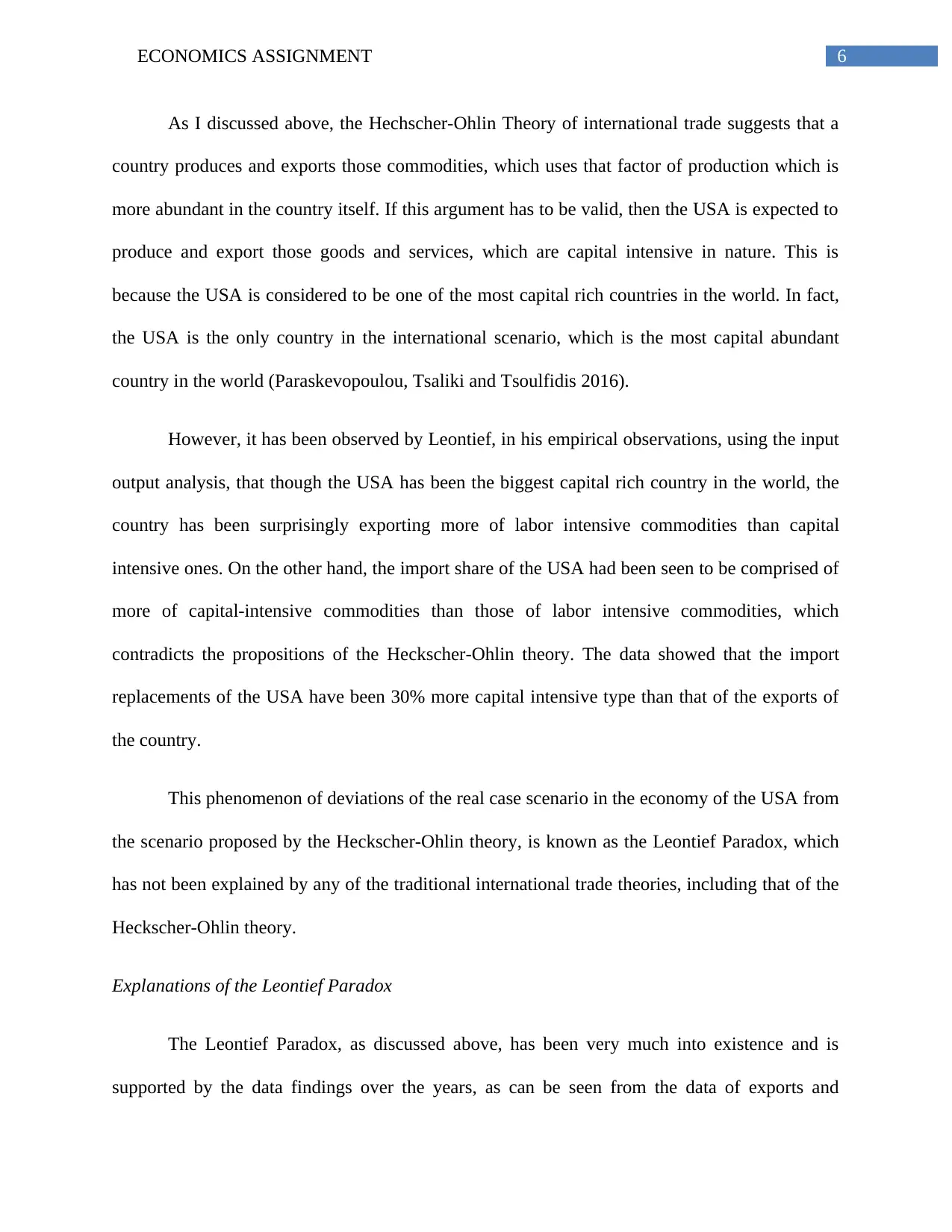
6ECONOMICS ASSIGNMENT
As I discussed above, the Hechscher-Ohlin Theory of international trade suggests that a
country produces and exports those commodities, which uses that factor of production which is
more abundant in the country itself. If this argument has to be valid, then the USA is expected to
produce and export those goods and services, which are capital intensive in nature. This is
because the USA is considered to be one of the most capital rich countries in the world. In fact,
the USA is the only country in the international scenario, which is the most capital abundant
country in the world (Paraskevopoulou, Tsaliki and Tsoulfidis 2016).
However, it has been observed by Leontief, in his empirical observations, using the input
output analysis, that though the USA has been the biggest capital rich country in the world, the
country has been surprisingly exporting more of labor intensive commodities than capital
intensive ones. On the other hand, the import share of the USA had been seen to be comprised of
more of capital-intensive commodities than those of labor intensive commodities, which
contradicts the propositions of the Heckscher-Ohlin theory. The data showed that the import
replacements of the USA have been 30% more capital intensive type than that of the exports of
the country.
This phenomenon of deviations of the real case scenario in the economy of the USA from
the scenario proposed by the Heckscher-Ohlin theory, is known as the Leontief Paradox, which
has not been explained by any of the traditional international trade theories, including that of the
Heckscher-Ohlin theory.
Explanations of the Leontief Paradox
The Leontief Paradox, as discussed above, has been very much into existence and is
supported by the data findings over the years, as can be seen from the data of exports and
As I discussed above, the Hechscher-Ohlin Theory of international trade suggests that a
country produces and exports those commodities, which uses that factor of production which is
more abundant in the country itself. If this argument has to be valid, then the USA is expected to
produce and export those goods and services, which are capital intensive in nature. This is
because the USA is considered to be one of the most capital rich countries in the world. In fact,
the USA is the only country in the international scenario, which is the most capital abundant
country in the world (Paraskevopoulou, Tsaliki and Tsoulfidis 2016).
However, it has been observed by Leontief, in his empirical observations, using the input
output analysis, that though the USA has been the biggest capital rich country in the world, the
country has been surprisingly exporting more of labor intensive commodities than capital
intensive ones. On the other hand, the import share of the USA had been seen to be comprised of
more of capital-intensive commodities than those of labor intensive commodities, which
contradicts the propositions of the Heckscher-Ohlin theory. The data showed that the import
replacements of the USA have been 30% more capital intensive type than that of the exports of
the country.
This phenomenon of deviations of the real case scenario in the economy of the USA from
the scenario proposed by the Heckscher-Ohlin theory, is known as the Leontief Paradox, which
has not been explained by any of the traditional international trade theories, including that of the
Heckscher-Ohlin theory.
Explanations of the Leontief Paradox
The Leontief Paradox, as discussed above, has been very much into existence and is
supported by the data findings over the years, as can be seen from the data of exports and
Paraphrase This Document
Need a fresh take? Get an instant paraphrase of this document with our AI Paraphraser
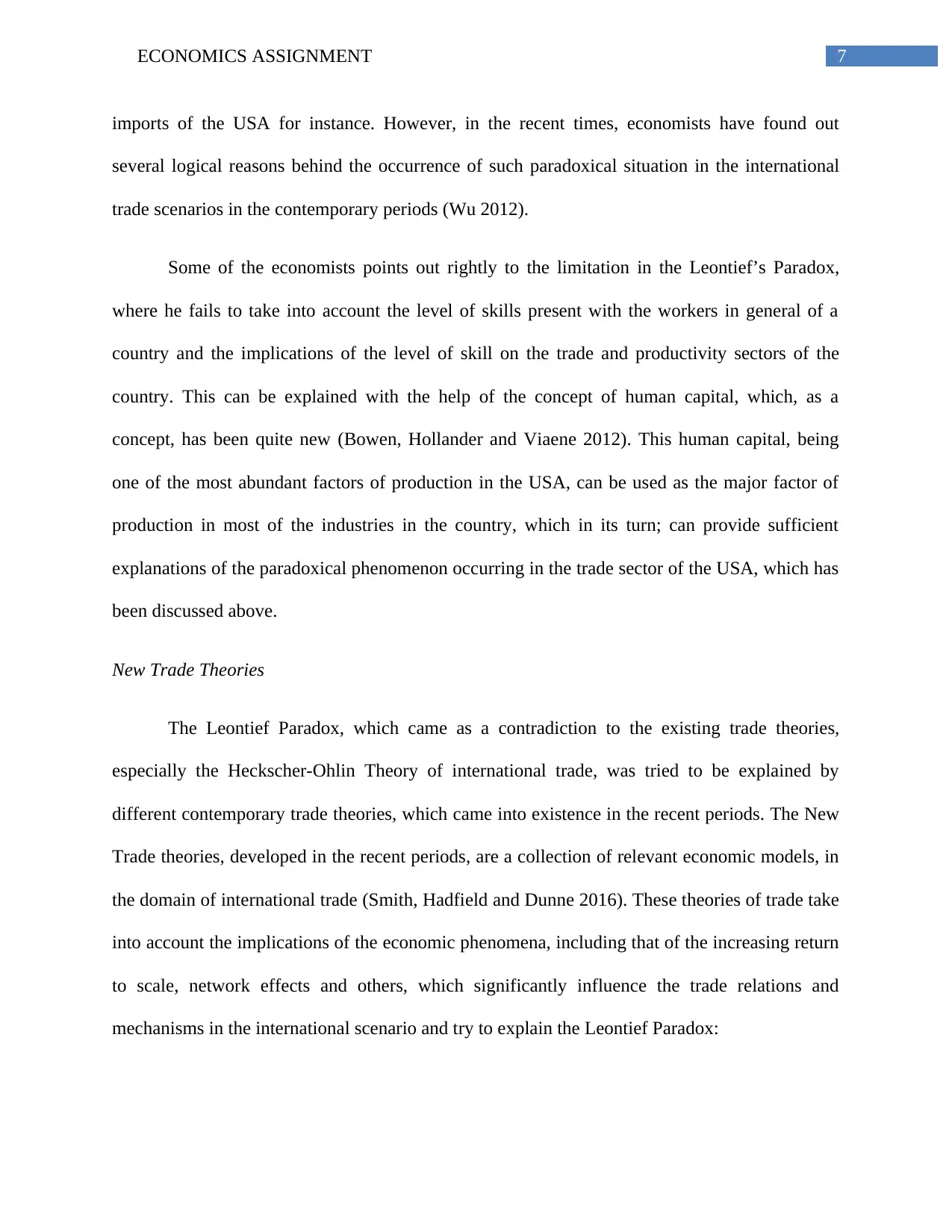
7ECONOMICS ASSIGNMENT
imports of the USA for instance. However, in the recent times, economists have found out
several logical reasons behind the occurrence of such paradoxical situation in the international
trade scenarios in the contemporary periods (Wu 2012).
Some of the economists points out rightly to the limitation in the Leontief’s Paradox,
where he fails to take into account the level of skills present with the workers in general of a
country and the implications of the level of skill on the trade and productivity sectors of the
country. This can be explained with the help of the concept of human capital, which, as a
concept, has been quite new (Bowen, Hollander and Viaene 2012). This human capital, being
one of the most abundant factors of production in the USA, can be used as the major factor of
production in most of the industries in the country, which in its turn; can provide sufficient
explanations of the paradoxical phenomenon occurring in the trade sector of the USA, which has
been discussed above.
New Trade Theories
The Leontief Paradox, which came as a contradiction to the existing trade theories,
especially the Heckscher-Ohlin Theory of international trade, was tried to be explained by
different contemporary trade theories, which came into existence in the recent periods. The New
Trade theories, developed in the recent periods, are a collection of relevant economic models, in
the domain of international trade (Smith, Hadfield and Dunne 2016). These theories of trade take
into account the implications of the economic phenomena, including that of the increasing return
to scale, network effects and others, which significantly influence the trade relations and
mechanisms in the international scenario and try to explain the Leontief Paradox:
imports of the USA for instance. However, in the recent times, economists have found out
several logical reasons behind the occurrence of such paradoxical situation in the international
trade scenarios in the contemporary periods (Wu 2012).
Some of the economists points out rightly to the limitation in the Leontief’s Paradox,
where he fails to take into account the level of skills present with the workers in general of a
country and the implications of the level of skill on the trade and productivity sectors of the
country. This can be explained with the help of the concept of human capital, which, as a
concept, has been quite new (Bowen, Hollander and Viaene 2012). This human capital, being
one of the most abundant factors of production in the USA, can be used as the major factor of
production in most of the industries in the country, which in its turn; can provide sufficient
explanations of the paradoxical phenomenon occurring in the trade sector of the USA, which has
been discussed above.
New Trade Theories
The Leontief Paradox, which came as a contradiction to the existing trade theories,
especially the Heckscher-Ohlin Theory of international trade, was tried to be explained by
different contemporary trade theories, which came into existence in the recent periods. The New
Trade theories, developed in the recent periods, are a collection of relevant economic models, in
the domain of international trade (Smith, Hadfield and Dunne 2016). These theories of trade take
into account the implications of the economic phenomena, including that of the increasing return
to scale, network effects and others, which significantly influence the trade relations and
mechanisms in the international scenario and try to explain the Leontief Paradox:
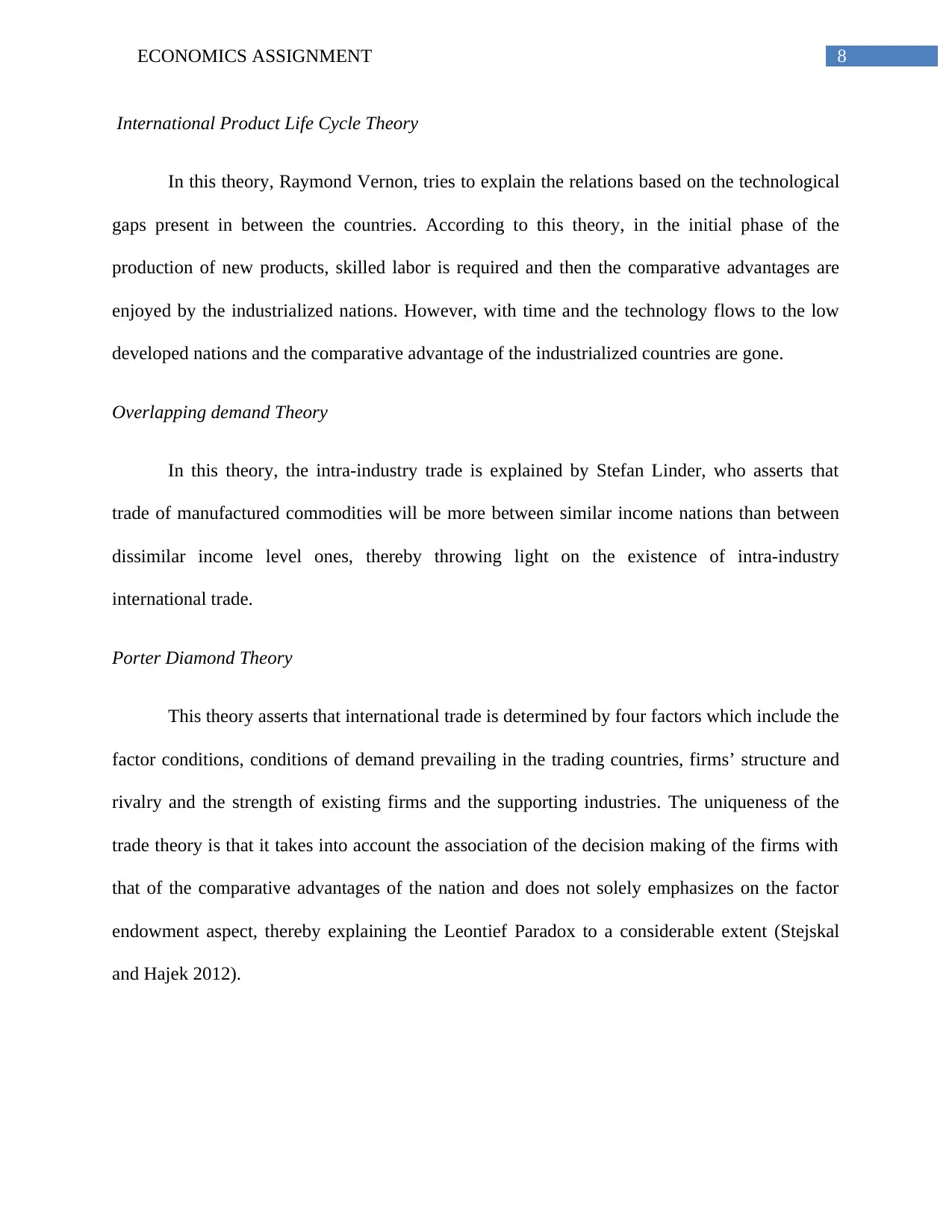
8ECONOMICS ASSIGNMENT
International Product Life Cycle Theory
In this theory, Raymond Vernon, tries to explain the relations based on the technological
gaps present in between the countries. According to this theory, in the initial phase of the
production of new products, skilled labor is required and then the comparative advantages are
enjoyed by the industrialized nations. However, with time and the technology flows to the low
developed nations and the comparative advantage of the industrialized countries are gone.
Overlapping demand Theory
In this theory, the intra-industry trade is explained by Stefan Linder, who asserts that
trade of manufactured commodities will be more between similar income nations than between
dissimilar income level ones, thereby throwing light on the existence of intra-industry
international trade.
Porter Diamond Theory
This theory asserts that international trade is determined by four factors which include the
factor conditions, conditions of demand prevailing in the trading countries, firms’ structure and
rivalry and the strength of existing firms and the supporting industries. The uniqueness of the
trade theory is that it takes into account the association of the decision making of the firms with
that of the comparative advantages of the nation and does not solely emphasizes on the factor
endowment aspect, thereby explaining the Leontief Paradox to a considerable extent (Stejskal
and Hajek 2012).
International Product Life Cycle Theory
In this theory, Raymond Vernon, tries to explain the relations based on the technological
gaps present in between the countries. According to this theory, in the initial phase of the
production of new products, skilled labor is required and then the comparative advantages are
enjoyed by the industrialized nations. However, with time and the technology flows to the low
developed nations and the comparative advantage of the industrialized countries are gone.
Overlapping demand Theory
In this theory, the intra-industry trade is explained by Stefan Linder, who asserts that
trade of manufactured commodities will be more between similar income nations than between
dissimilar income level ones, thereby throwing light on the existence of intra-industry
international trade.
Porter Diamond Theory
This theory asserts that international trade is determined by four factors which include the
factor conditions, conditions of demand prevailing in the trading countries, firms’ structure and
rivalry and the strength of existing firms and the supporting industries. The uniqueness of the
trade theory is that it takes into account the association of the decision making of the firms with
that of the comparative advantages of the nation and does not solely emphasizes on the factor
endowment aspect, thereby explaining the Leontief Paradox to a considerable extent (Stejskal
and Hajek 2012).
⊘ This is a preview!⊘
Do you want full access?
Subscribe today to unlock all pages.

Trusted by 1+ million students worldwide
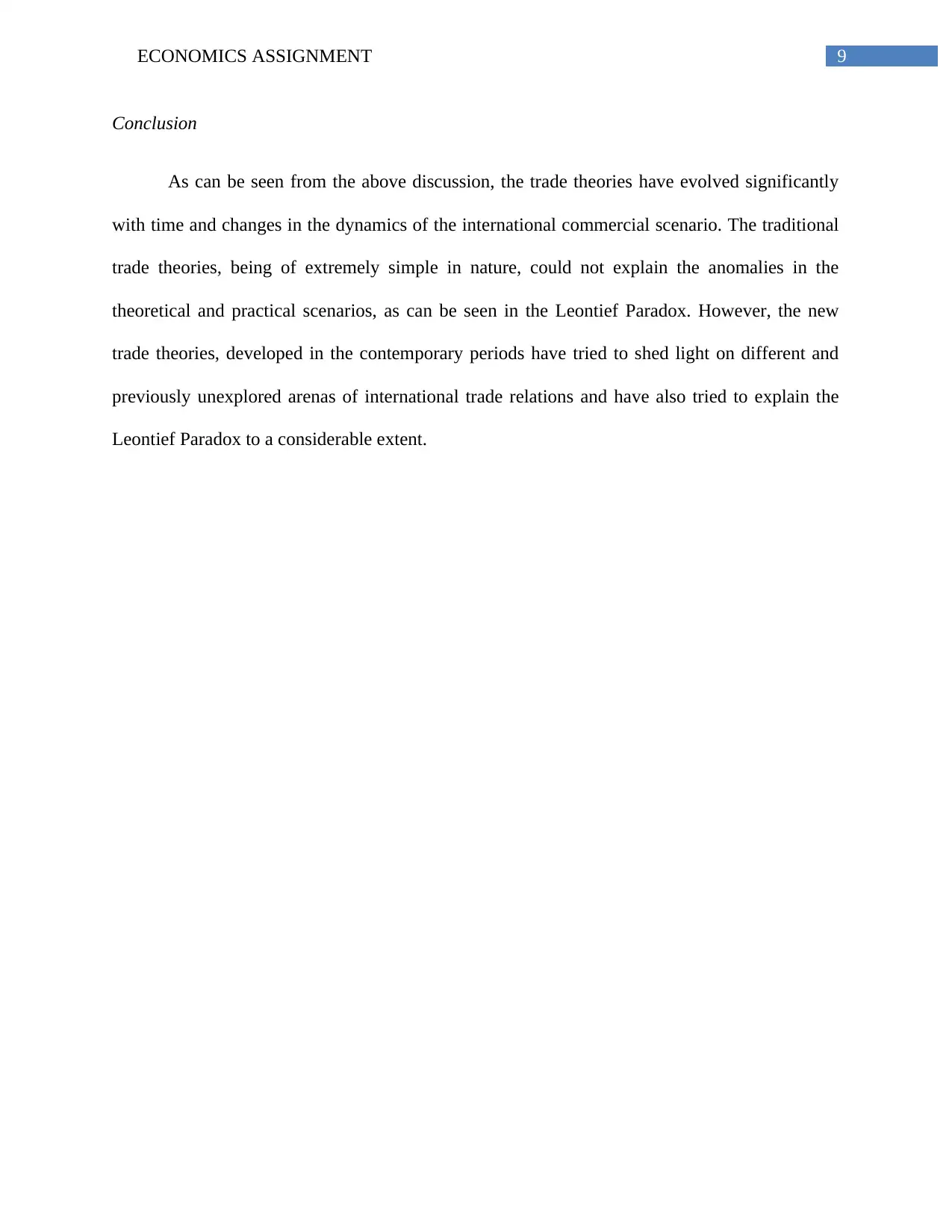
9ECONOMICS ASSIGNMENT
Conclusion
As can be seen from the above discussion, the trade theories have evolved significantly
with time and changes in the dynamics of the international commercial scenario. The traditional
trade theories, being of extremely simple in nature, could not explain the anomalies in the
theoretical and practical scenarios, as can be seen in the Leontief Paradox. However, the new
trade theories, developed in the contemporary periods have tried to shed light on different and
previously unexplored arenas of international trade relations and have also tried to explain the
Leontief Paradox to a considerable extent.
Conclusion
As can be seen from the above discussion, the trade theories have evolved significantly
with time and changes in the dynamics of the international commercial scenario. The traditional
trade theories, being of extremely simple in nature, could not explain the anomalies in the
theoretical and practical scenarios, as can be seen in the Leontief Paradox. However, the new
trade theories, developed in the contemporary periods have tried to shed light on different and
previously unexplored arenas of international trade relations and have also tried to explain the
Leontief Paradox to a considerable extent.
Paraphrase This Document
Need a fresh take? Get an instant paraphrase of this document with our AI Paraphraser
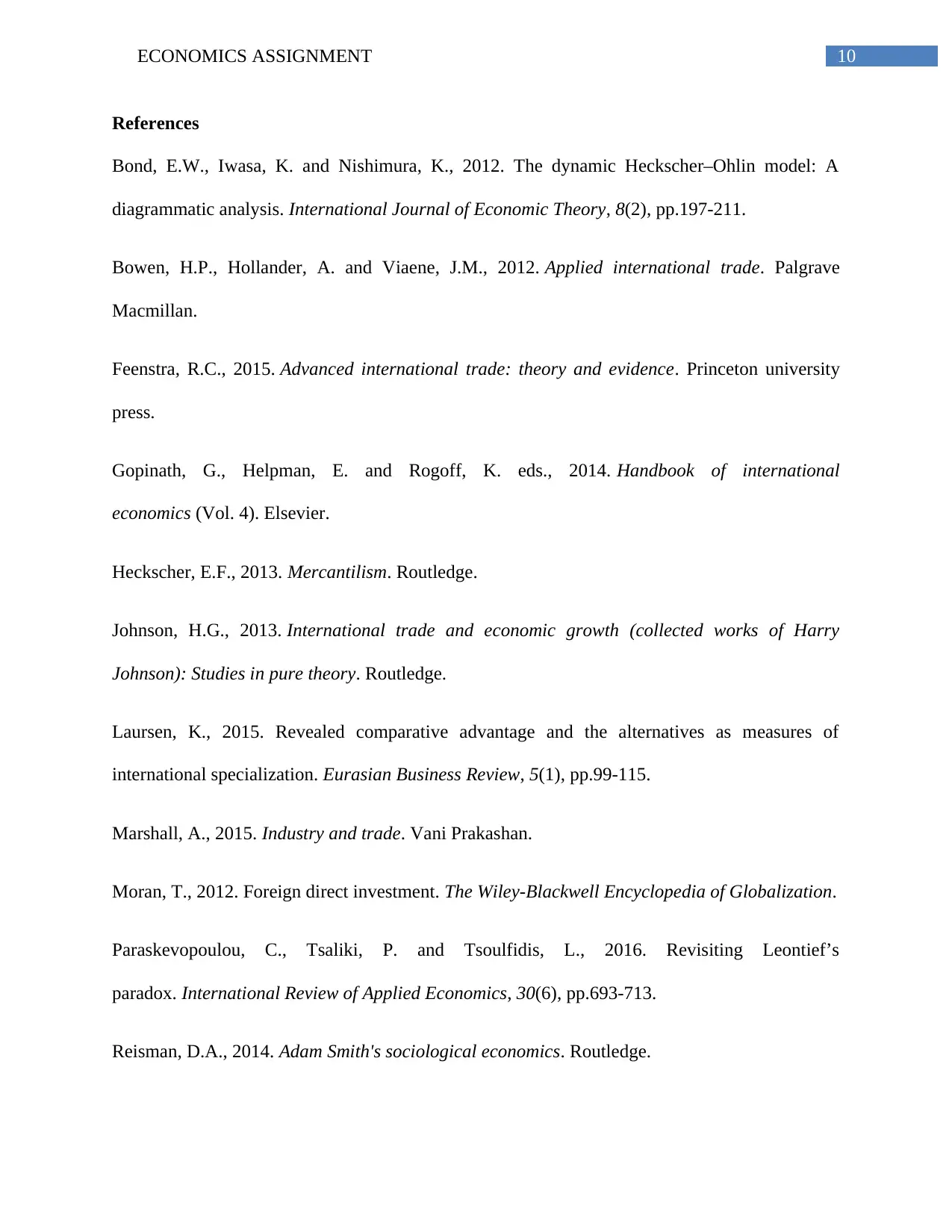
10ECONOMICS ASSIGNMENT
References
Bond, E.W., Iwasa, K. and Nishimura, K., 2012. The dynamic Heckscher–Ohlin model: A
diagrammatic analysis. International Journal of Economic Theory, 8(2), pp.197-211.
Bowen, H.P., Hollander, A. and Viaene, J.M., 2012. Applied international trade. Palgrave
Macmillan.
Feenstra, R.C., 2015. Advanced international trade: theory and evidence. Princeton university
press.
Gopinath, G., Helpman, E. and Rogoff, K. eds., 2014. Handbook of international
economics (Vol. 4). Elsevier.
Heckscher, E.F., 2013. Mercantilism. Routledge.
Johnson, H.G., 2013. International trade and economic growth (collected works of Harry
Johnson): Studies in pure theory. Routledge.
Laursen, K., 2015. Revealed comparative advantage and the alternatives as measures of
international specialization. Eurasian Business Review, 5(1), pp.99-115.
Marshall, A., 2015. Industry and trade. Vani Prakashan.
Moran, T., 2012. Foreign direct investment. The Wiley-Blackwell Encyclopedia of Globalization.
Paraskevopoulou, C., Tsaliki, P. and Tsoulfidis, L., 2016. Revisiting Leontief’s
paradox. International Review of Applied Economics, 30(6), pp.693-713.
Reisman, D.A., 2014. Adam Smith's sociological economics. Routledge.
References
Bond, E.W., Iwasa, K. and Nishimura, K., 2012. The dynamic Heckscher–Ohlin model: A
diagrammatic analysis. International Journal of Economic Theory, 8(2), pp.197-211.
Bowen, H.P., Hollander, A. and Viaene, J.M., 2012. Applied international trade. Palgrave
Macmillan.
Feenstra, R.C., 2015. Advanced international trade: theory and evidence. Princeton university
press.
Gopinath, G., Helpman, E. and Rogoff, K. eds., 2014. Handbook of international
economics (Vol. 4). Elsevier.
Heckscher, E.F., 2013. Mercantilism. Routledge.
Johnson, H.G., 2013. International trade and economic growth (collected works of Harry
Johnson): Studies in pure theory. Routledge.
Laursen, K., 2015. Revealed comparative advantage and the alternatives as measures of
international specialization. Eurasian Business Review, 5(1), pp.99-115.
Marshall, A., 2015. Industry and trade. Vani Prakashan.
Moran, T., 2012. Foreign direct investment. The Wiley-Blackwell Encyclopedia of Globalization.
Paraskevopoulou, C., Tsaliki, P. and Tsoulfidis, L., 2016. Revisiting Leontief’s
paradox. International Review of Applied Economics, 30(6), pp.693-713.
Reisman, D.A., 2014. Adam Smith's sociological economics. Routledge.
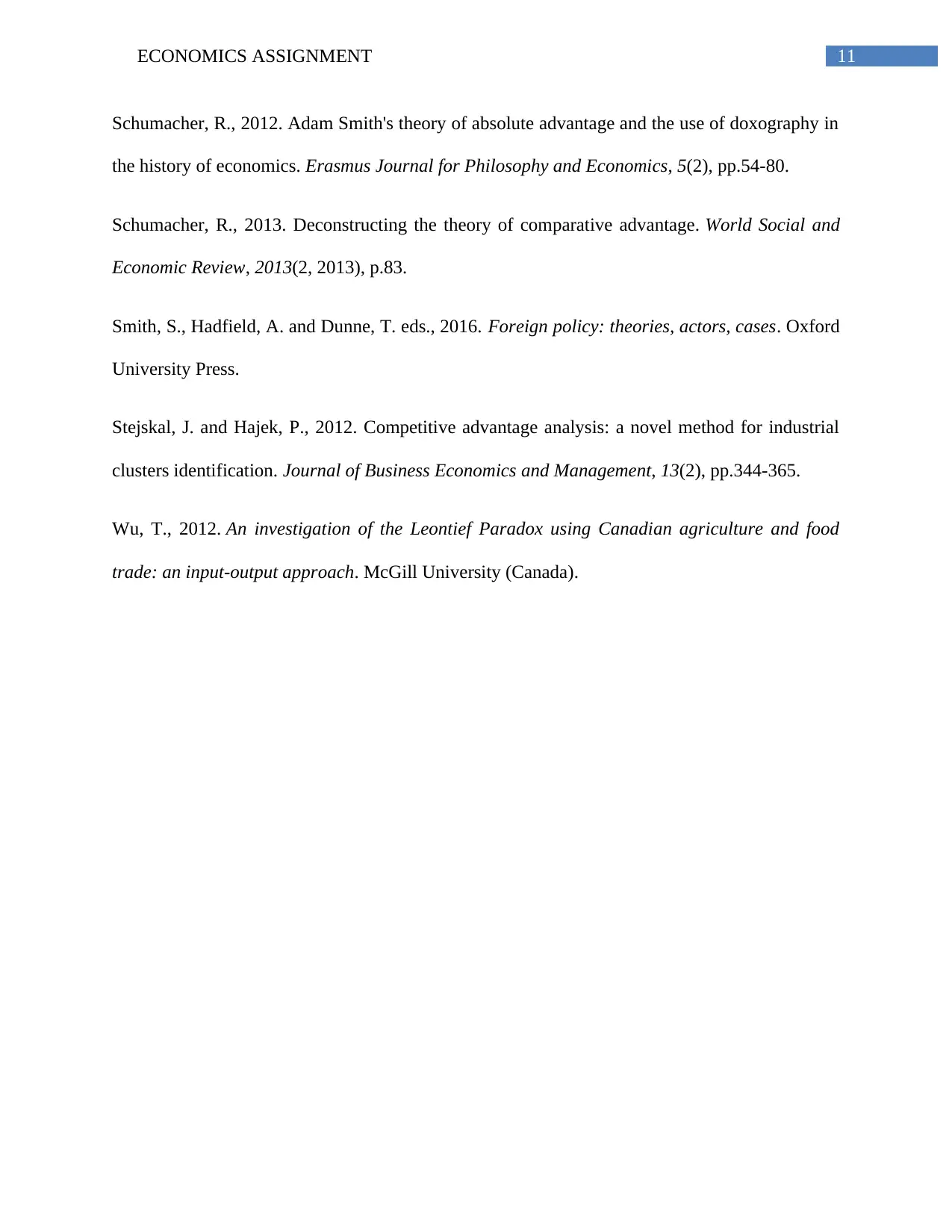
11ECONOMICS ASSIGNMENT
Schumacher, R., 2012. Adam Smith's theory of absolute advantage and the use of doxography in
the history of economics. Erasmus Journal for Philosophy and Economics, 5(2), pp.54-80.
Schumacher, R., 2013. Deconstructing the theory of comparative advantage. World Social and
Economic Review, 2013(2, 2013), p.83.
Smith, S., Hadfield, A. and Dunne, T. eds., 2016. Foreign policy: theories, actors, cases. Oxford
University Press.
Stejskal, J. and Hajek, P., 2012. Competitive advantage analysis: a novel method for industrial
clusters identification. Journal of Business Economics and Management, 13(2), pp.344-365.
Wu, T., 2012. An investigation of the Leontief Paradox using Canadian agriculture and food
trade: an input-output approach. McGill University (Canada).
Schumacher, R., 2012. Adam Smith's theory of absolute advantage and the use of doxography in
the history of economics. Erasmus Journal for Philosophy and Economics, 5(2), pp.54-80.
Schumacher, R., 2013. Deconstructing the theory of comparative advantage. World Social and
Economic Review, 2013(2, 2013), p.83.
Smith, S., Hadfield, A. and Dunne, T. eds., 2016. Foreign policy: theories, actors, cases. Oxford
University Press.
Stejskal, J. and Hajek, P., 2012. Competitive advantage analysis: a novel method for industrial
clusters identification. Journal of Business Economics and Management, 13(2), pp.344-365.
Wu, T., 2012. An investigation of the Leontief Paradox using Canadian agriculture and food
trade: an input-output approach. McGill University (Canada).
⊘ This is a preview!⊘
Do you want full access?
Subscribe today to unlock all pages.

Trusted by 1+ million students worldwide
1 out of 12
Related Documents
Your All-in-One AI-Powered Toolkit for Academic Success.
+13062052269
info@desklib.com
Available 24*7 on WhatsApp / Email
![[object Object]](/_next/static/media/star-bottom.7253800d.svg)
Unlock your academic potential
Copyright © 2020–2025 A2Z Services. All Rights Reserved. Developed and managed by ZUCOL.





